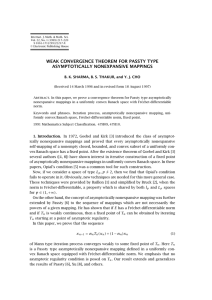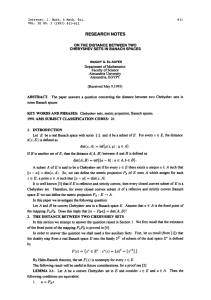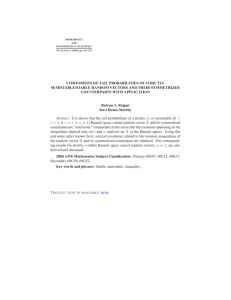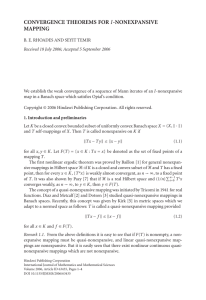FIXED POINT THEOREMS FOR NONEXPANSIVE MAPPINGS
advertisement
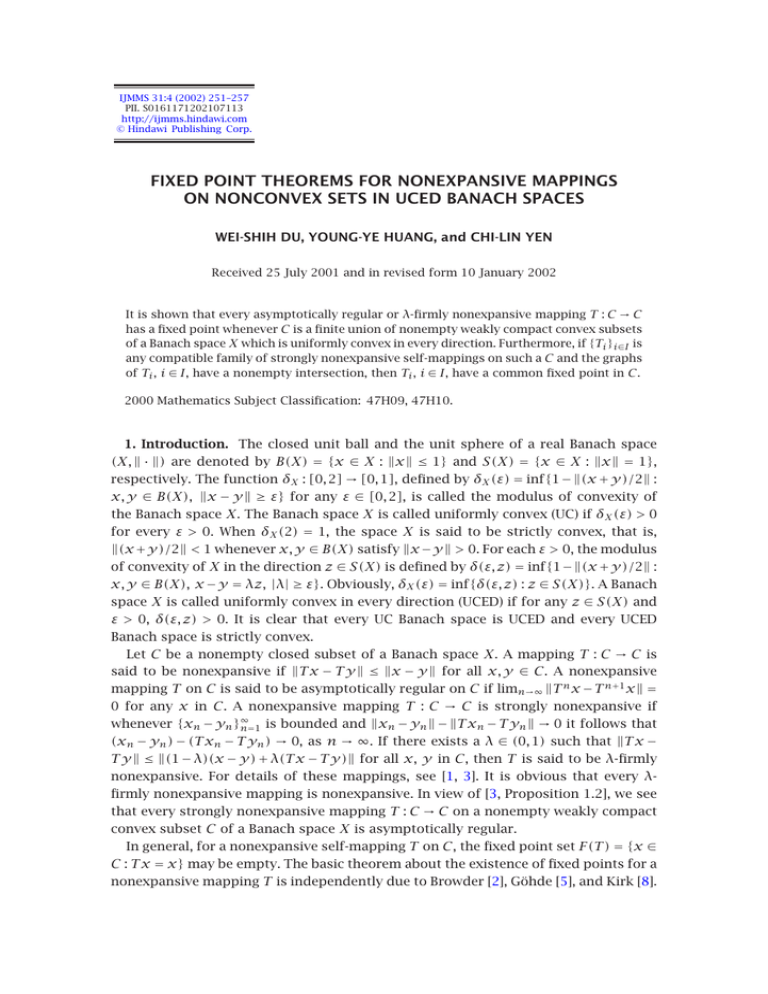
IJMMS 31:4 (2002) 251–257
PII. S0161171202107113
http://ijmms.hindawi.com
© Hindawi Publishing Corp.
FIXED POINT THEOREMS FOR NONEXPANSIVE MAPPINGS
ON NONCONVEX SETS IN UCED BANACH SPACES
WEI-SHIH DU, YOUNG-YE HUANG, and CHI-LIN YEN
Received 25 July 2001 and in revised form 10 January 2002
It is shown that every asymptotically regular or λ-firmly nonexpansive mapping T : C → C
has a fixed point whenever C is a finite union of nonempty weakly compact convex subsets
of a Banach space X which is uniformly convex in every direction. Furthermore, if {Ti }i∈I is
any compatible family of strongly nonexpansive self-mappings on such a C and the graphs
of Ti , i ∈ I, have a nonempty intersection, then Ti , i ∈ I, have a common fixed point in C.
2000 Mathematics Subject Classification: 47H09, 47H10.
1. Introduction. The closed unit ball and the unit sphere of a real Banach space
(X, · ) are denoted by B(X) = {x ∈ X : x ≤ 1} and S(X) = {x ∈ X : x = 1},
respectively. The function δX : [0, 2] → [0, 1], defined by δX (ε) = inf{1 − (x + y)/2 :
x, y ∈ B(X), x − y ≥ ε} for any ε ∈ [0, 2], is called the modulus of convexity of
the Banach space X. The Banach space X is called uniformly convex (UC) if δX (ε) > 0
for every ε > 0. When δX (2) = 1, the space X is said to be strictly convex, that is,
(x +y)/2 < 1 whenever x, y ∈ B(X) satisfy x −y > 0. For each ε > 0, the modulus
of convexity of X in the direction z ∈ S(X) is defined by δ(ε, z) = inf{1−(x +y)/2 :
x, y ∈ B(X), x −y = λz, |λ| ≥ ε}. Obviously, δX (ε) = inf{δ(ε, z) : z ∈ S(X)}. A Banach
space X is called uniformly convex in every direction (UCED) if for any z ∈ S(X) and
ε > 0, δ(ε, z) > 0. It is clear that every UC Banach space is UCED and every UCED
Banach space is strictly convex.
Let C be a nonempty closed subset of a Banach space X. A mapping T : C → C is
said to be nonexpansive if T x − T y ≤ x − y for all x, y ∈ C. A nonexpansive
mapping T on C is said to be asymptotically regular on C if limn→∞ T n x − T n+1 x =
0 for any x in C. A nonexpansive mapping T : C → C is strongly nonexpansive if
whenever {xn − yn }∞
n=1 is bounded and xn − yn − T xn − T yn → 0 it follows that
(xn − yn ) − (T xn − T yn ) → 0, as n → ∞. If there exists a λ ∈ (0, 1) such that T x −
T y ≤ (1 − λ)(x − y) + λ(T x − T y) for all x, y in C, then T is said to be λ-firmly
nonexpansive. For details of these mappings, see [1, 3]. It is obvious that every λfirmly nonexpansive mapping is nonexpansive. In view of [3, Proposition 1.2], we see
that every strongly nonexpansive mapping T : C → C on a nonempty weakly compact
convex subset C of a Banach space X is asymptotically regular.
In general, for a nonexpansive self-mapping T on C, the fixed point set F (T ) = {x ∈
C : T x = x} may be empty. The basic theorem about the existence of fixed points for a
nonexpansive mapping T is independently due to Browder [2], Göhde [5], and Kirk [8].
252
WEI-SHIH DU ET AL.
From the point of view of fixed point theorem for the class of closed convex subset
C, λ-firmly nonexpansive mappings T : C → C do not exhibit better behavior than
nonexpansive mappings (cf. [4, page 43]). However, the story is completely different
if C is nonconvex. For details, see Smarzewski [9], whose work was extended by Hong
and Huang [6] to a weakly commutative family of λ-firmly nonexpansive mappings
instead of a single mapping. In this paper, we show that the Smarzewski fixed point
theorem for λ-firmly nonexpansive mappings remains true when the underlying space
is a UCED Banach space. Further, the fixed point problem for asymptotically regular
or strongly nonexpansive self-mappings on a nonconvex subset of a UCED Banach
space is also investigated. It is shown that every asymptotically regular nonexpansive
mapping T : C → C has a fixed point whenever C is a finite union of nonempty weakly
compact convex subsets Ck of a UCED Banach space. Moreover, if {Ti }i∈I is any compatible family of strongly nonexpansive self-mappings on such a C and the graphs of
Ti , i ∈ I, have nonempty intersection, then Ti , i ∈ I, have a common fixed point in C.
2. Fixed point theorems for asymptotically regular or λ-firmly nonexpansive
mappings. Let C be a nonempty subset of a Banach space X and {xj } a bounded sequence in X. The asymptotic radius of {xj } at a point x ∈ X is the number limj→∞ x −
xj and is denoted by r (x, {xj }). The number r (C, {xj }), defined by inf{r (x, {xj }) :
x ∈ C}, is called the asymptotic radius of {xj } with respect to C. A point z in C is
said to be an asymptotic center of {xj } with respect to C if r (z, {xj }) = r (C, {xj }).
The set of all asymptotic centers is denoted by A(C, {xj }).
In this section, we show that every bounded sequence {xj } in a UCED Banach space
X has a unique asymptotic center with respect to any nonempty weakly compact
convex subset C of X, and then apply this result to study the fixed point property for
asymptotic regular or λ-firmly nonexpansive mappings.
Lemma 2.1. Let C be any nonempty weakly compact convex subset of a Banach
space X. Then for any bounded sequence {xj } in X, A(C, {xj }) is nonempty.
Proof. This follows from the observation that f : C → [0, ∞) defined by f (x) =
r (x, {xj }) for x ∈ C is norm continuous and convex, therefore, weakly lower semicontinuous, and so attains its minimum on the weakly compact set C.
Lemma 2.2. Every bounded sequence in a UCED Banach space X has a unique asymptotic center with respect to any nonempty weakly compact convex subset of X.
Proof. Let {xj } be any bounded sequence in X and C a nonempty weakly compact
convex subset of X. Put f (x) = r (x, {xj }) for x ∈ X and denote r (C, {xj }) by m. By
Lemma 2.1, it suffices to show that A(C, {xj }) consists of exactly one point. Assume
that there were two distinct points u and v in A(C, {xj }). Then m > 0 and u−v = λz
for some λ > 0 and z ∈ S(X). Since X is UCED, for the above z and ε := (m+1)−1 λ > 0,
we have δ(ε, z) > 0. Choose η ∈ (0, 1) so that (m + η)(1 − δ(ε, z)) < m. Then, xj −
u ≤ m + η and xj − v ≤ m + η for all sufficiently large j. Let p = (1/2)(u + v),
which is in C by the convexity of C. The uniform convexity in the direction z implies
that xj − p ≤ (1 − δ(ε, z))(m + η) for all sufficiently large j once we note that
FIXED POINT THEOREMS FOR NONEXPANSIVE MAPPINGS . . .
1 xj − u xj − v ,
+
(m + η)−1 xj − p = 2 m+η m+η (m + η)−1 xj − v ≤ 1,
(m + η)−1 xj − u ≤ 1,
253
(2.1)
(m + η)−1 xj − v − xj − u = (m + η)−1 (u − v) = (m + η)−1 λz
with (m +η)−1 λ ≥ ε. Hence f (p) < m, a contradiction. Therefore, A(C, {xj }) consists
of exactly one point.
n
Lemma 2.3. Let C = Yk=1
Ck be a finite union of nonempty weakly compact convex
subsets Ck of a UCED Banach space X, and let uk ∈ Ck be the unique asymptotic center
of a bounded sequence {xj } in X with respect to Ck , 1 ≤ k ≤ n. Then
r C, xj = min r uk , xj : 1 ≤ k ≤ n .
(2.2)
Proof. Let m = min{r (uk , {xj }) : k = 1, 2, . . . , n}. Then for any x ∈ C, there is i
such that x ∈ Ci , and so
r x, xj ≥ r Ci , xj = r ui , xj ≥ m.
(2.3)
Taking the infimum for x over C yields r (C, {xj }) ≥ m. On the other hand, choose
i ∈ {1, 2, . . . , n} such that r (ui , {xj }) = m. Then,
m = r ui , xj = r Ci , xj ≥ inf r x, xj : x ∈ C = r C, xj .
(2.4)
This completes the proof.
Lemma 2.4. Under the same hypothesis as Lemma 2.3,
A C, xj = ui : r ui , xj = m ≠ ∅,
(2.5)
m = min r uk , xj : 1 ≤ k ≤ n .
(2.6)
where
Proof. If ui satisfies r (ui , {xj }) = m, then it follows from Lemma 2.3 that
r (ui , {xj }) = r (C, {xj }), which implies that ui ∈ A(C, {xj }). For the other inclusion,
let v be any member of A(C, {xj }). Choose Ck such that v ∈ Ck . Then
r v, xj = m ≤ r uk , xj ≤ r v, xj ,
(2.7)
so r (v, {xj }) = m = r (uk , {xj }). By the uniqueness of the asymptotic center, we see
that v = uk ∈ {ui : r (ui , {xj }) = m}.
Lemma 2.5. Under the same hypothesis as Lemma 2.3, and suppose that T : C → C
is nonexpansive. Then for any z ∈ C, A(C, {T j z}∞
j=1 ) is T -invariant.
254
WEI-SHIH DU ET AL.
Proof. For each k ∈ {1, 2, . . . , n}, let uk ∈ Ck be the unique asymptotic center of
{T j z} with respect to the nonempty weakly compact convex subset Ck , 1 ≤ k ≤ n.
Define f : X → [0, ∞) by f (x) = r (x, {T j z}) for x ∈ X. Then by Lemma 2.4,
∅ ≠ A C, T j z = ui : f ui = m ,
m = min r uk , T j z : k = 1, 2, . . . , n . (2.8)
Since T is nonexpansive, for any k ∈ {1, 2, . . . , n}, we have
f T uk = lim T uk − T j z ≤ lim uk − T j−1 z = f uk .
j→∞
j→∞
(2.9)
Now, for any a ∈ A(C, {T j z}), it follows from (2.8) and (2.9) that
m = f (a) ≥ f (T a) ≥ inf f (x) = m.
x∈C
(2.10)
Consequently, f (T a) = m. Appealing to (2.8) once more, we obtain that T a ∈
A(C, {T j z}). This completes the proof.
With the aid of Lemmas 2.3, 2.4, and 2.5, we obtain one of our main results.
n
Theorem 2.6. Let C = k=1 Ck be a finite union of nonempty weakly compact convex
subsets Ck of a UCED Banach space X. Suppose that T : C → C is an asymptotically
regular nonexpansive mapping. Then T has a fixed point in C.
Proof. Choose any z ∈ C. Since C is T -invariant and C is bounded, the sequence
{T j z}∞
j=1 ⊂ C is bounded. For any k ∈ {1, 2, . . . , n}, let uk ∈ Ck be the unique asymptotic
center of {T j z} with respect to the nonempty weakly compact convex subset Ck of
X. By Lemmas 2.4 and 2.5, A(C, {T j z}) is a nonempty subset of {u1 , . . . , un } and is
T -invariant. For any a ∈ A(C, {T j z}), we see via the finiteness of A(C, {T j z}) that
there are distinct positive integers p, q such that T p a = T q a. Assume that q = p + r
for some r ∈ N. Define w = T p a ∈ A(C, {T j z}). Then
w = T p a = T q a = T r T p a = T r w.
(2.11)
This means that w is a fixed point of T r . Put nk = kr , k ∈ N. It follows from the
asymptotic regularity of T at w that
T w − w = T nk +1 w − T nk w → 0 as nk → ∞.
(2.12)
Hence T w = w. This completes the proof.
Since it is not known whether every λ-firmly nonexpansive mapping is asymptotic
regular, the generalization of the Smarzewski fixed point theorem to λ-firmly nonexpansive mappings does not follow directly from Theorem 2.6. However, the proof
of the following theorem is similar to that of Theorem 2.6. To begin, we recall the
following known lemma.
Lemma 2.7 [6, Lemma 2.2]. Suppose that C is any nonempty subset of a strictly
convex Banach space X, and that T : C → C is a λ-firmly nonexpansive mapping for
some λ ∈ (0, 1). If x, y are in C so that T x − T y = x − y, then T x − T y = x − y.
FIXED POINT THEOREMS FOR NONEXPANSIVE MAPPINGS . . .
255
n
Theorem 2.8. Let C = k=1 Ck be a finite union of nonempty weakly compact convex
subsets Ck of a UCED Banach space X. If T : C → C is λ-firmly nonexpansive for some
λ ∈ (0, 1), then T has a fixed point in C.
Proof. Choose any z ∈ C. The sequence {T j z}∞
j=1 is bounded in C. So, it follows
from Lemma 2.2 that for any k ∈ {1, 2, . . . , n}, {T j z} has a unique asymptotic center
uk with respect to the nonempty weakly compact convex subset Ck . By Lemmas 2.4
and 2.5, A(C, {T j z}) is a nonempty subset of {u1 , . . . , un } and is T -invariant. So, there
is w ∈ A(C, {T j z}) and ∈ N such that T w = w. If = 1, T has a fixed point w in C.
Otherwise, noting that
w − T w = T w − T +1 w ≤ T −1 w − T w ≤ · · · ≤ T w − T 2 w ≤ w − T w,
(2.13)
it follows from Lemma 2.7 that
w − T w = T w − T 2 w = · · · = T −1 w − T w,
(2.14)
which implies that
w = T w = T −1 w − x
= T −2 w − x − x
= T −2 w − 2x
(2.15)
..
.
= w − x,
where x = w − T w.
Consequently, x = 0 and hence x = 0, that is, T w = w. This completes the proof.
For the case that k = 1, we have the following corollary.
Corollary 2.9. Let C be a nonempty weakly compact convex subset of a UCED
Banach space X. Suppose T : C → C is a λ-firmly nonexpansive mapping for some
λ ∈ (0, 1). Then T has a fixed point in C.
The following conclusion is immediate from Theorem 2.8 and the fact that every
uniformly convex Banach space is a UCED Banach space.
n
Corollary 2.10 [9]. Suppose that C = k=1 Ck is a finite union of nonempty weakly
compact convex subsets Ck of a uniformly convex Banach space X and that T : C → C
is a λ-firmly nonexpansive mapping for some λ ∈ (0, 1). Then T has a fixed point in C.
3. A common fixed point theorem for strongly nonexpansive mappings. By [3,
Proposition 1.2], it is easy to see that every strongly nonexpansive mapping T : C → C
on a nonempty bounded closed subset C of a Banach space X is asymptotically regular.
With this observation, the result of Theorem 2.6 can be strengthened.
n
Theorem 3.1. Let X be a UCED Banach space, and let C = k=1 Ck be a finite
union of nonempty weakly compact convex subsets Ck of X. Suppose that T : C → C
256
WEI-SHIH DU ET AL.
is a strongly nonexpansive mapping. Then for any z in C, A(C, {T j z}∞
j=1 ) ≠ ∅ and
)
⊆
F
(T
).
A(C, {T j z}∞
j=1
Proof. For each k ∈ {1, 2, . . . , n}, let uk ∈ Ck be the unique asymptotic center of
{T j z} with respect to Ck . By Lemmas 2.4 and 2.5, we see that A(C, {T j z}) is a finite nonempty subset of {u1 , . . . , un } and is T -invariant. Moreover, from the proof of
Theorem 2.6, we see that for any a ∈ A(C, {T j z}) there is ∈ N such that T a is a
fixed point of T . Let η = T −1 a and w = T a. Then T η = w and T w = w. Let m be the
asymptotic radius of {T j z} with respect to C. Then
lim η − T j z = m = lim w − T j z = lim w − T j z,
j→∞
j→∞
j→∞
(3.1)
where the last equality follows from the monotonicity of the sequence {w −T j z}∞
j=1 .
Now we claim that limj→∞ η − T j z = m, also. In fact, by the nonexpansiveness of T
we see that
lim T η − T j+1 z ≤ lim η − T j z,
(3.2)
j→∞
j→∞
and hence
m = lim η − T j z ≥ lim η − T j z ≥ lim T η − T j+1 z
j→∞
j→∞
= lim w − T j+1 z = m.
j→∞
(3.3)
j→∞
Therefore, we have
w − T j z − T w − T j+1 z → 0,
η − T j z − T η − T j+1 z → 0 as j → ∞.
(3.4)
It then follows from the strong nonexpansiveness of T that
w − T j z − T w − T j+1 z → 0,
η − T j z − T η − T j+1 z → 0 as j → ∞.
(3.5)
Since
η − T η = (η − w) − (T η − T w)
≤ η − T j z − T η − T j+1 z + w − T j z − T w − T j+1 z ,
(3.6)
we conclude that η = T η. Thus, we have shown that T −1 a is also a fixed point of T
whenever T a is a fixed point of T . Repeating this argument, we finally obtain that a
is a fixed point of T . This completes the proof.
A family {Ti }i∈I of self-mappings on a metric space (X, d) is said to be weakly
commutative if d(Ti Tj x, Tj Ti x) ≤ d(Tj x, Ti x) for any i, j ∈ I and for any x in X.
{Ti }i∈I is said to be compatible if limn→∞ d(Ti Tj xn , Tj Ti xn ) = 0 whenever {xn } is
a sequence in X such that for some t ∈ X, limn→∞ Ti (xn ) = limn→∞ Tj (xn ) = t for all
i, j ∈ I. Obviously, a weakly commutative family is compatible but not conversely ([7]).
Just as the proof of [7, Proposition 2.2], we have the following lemma.
FIXED POINT THEOREMS FOR NONEXPANSIVE MAPPINGS . . .
257
Lemma 3.2. Suppose that {Ti }i∈I is a compatible family of self-mappings on a metric
space (X, d). If z ∈ X is such that Ti z = Tj z for all i, j ∈ I, then Ti Tj z = Tj Ti z for all
i, j ∈ I.
n
Theorem 3.3. Let C = k=1 Ck be a finite union of nonempty weakly compact convex
subsets Ck of a UCED Banach space X, and let {Ti }i∈I be any compatible family of
strongly nonexpansive self-mappings on C. Suppose that the graphs of Ti , i ∈ I, have a
nonempty intersection, then Ti , i ∈ I, have a common fixed point in C.
Proof. By assumption, there is z ∈ C such that Ti z = Tj z for all i, j ∈ I. Then in
view of Lemma 3.2, we have Ti Tj z = Tj Ti z for all i, j ∈ I. Consequently,
Ti2 z = Ti Tj z = Tj Ti z = Tj2 z,
(3.7)
for all i, j ∈ I. By induction, we obtain that Tik z = Tjk z for any k ∈ N and for all i, j ∈ I.
Then from the proof of Theorem 3.1, we see that A(C, {Tin z}∞
n=1 ) ≠ ∅ and any point
w in A(C, {Tin z}∞
)
is
a
common
fixed
point
of
T
,
j
∈
I.
This
completes the proof.
j
n=1
References
[1]
[2]
[3]
[4]
[5]
[6]
[7]
[8]
[9]
J. B. Baillon, R. E. Bruck, and S. Reich, On the asymptotic behavior of nonexpansive mappings
and semigroups in Banach spaces, Houston J. Math. 4 (1978), no. 1, 1–9.
F. E. Browder, Nonexpansive nonlinear operators in a Banach space, Proc. Nat. Acad. Sci.
U.S.A. 54 (1965), 1041–1044.
R. E. Bruck and S. Reich, Nonexpansive projections and resolvents of accretive operators in
Banach spaces, Houston J. Math. 3 (1977), no. 4, 459–470.
K. Goebel and S. Reich, Uniform Convexity, Hyperbolic Geometry, and Nonexpansive Mappings, Monographs and Textbooks in Pure and Applied Mathematics, vol. 83, Marcel
Dekker, New York, 1984.
D. Göhde, Zum Prinzip der kontraktiven Abbildung, Math. Nachr. 30 (1965), 251–258 (German).
Y. M. Hong and Y. Y. Huang, On λ-firmly nonexpansive mappings in nonconvex sets, Bull.
Inst. Math. Acad. Sinica 21 (1993), no. 1, 35–42.
G. Jungck, Compatible mappings and common fixed points, Int. J. Math. Math. Sci. 9 (1986),
no. 4, 771–779.
W. A. Kirk, A fixed point theorem for mappings which do not increase distances, Amer.
Math. Monthly 72 (1965), 1004–1006.
R. Smarzewski, On firmly nonexpansive mappings, Proc. Amer. Math. Soc. 113 (1991), no. 3,
723–725.
Wei-Shih Du: Department of Mathematics, National Changhua University of Education, Changhua 500, Taiwan, R.O.C.
E-mail address: dws58043@ms38.hinet.net
Young-Ye Huang: Department of Mathematics, National Cheng Kung University,
Tainan 701, Taiwan, R.O.C.
E-mail address: yue@math.ncku.edu.tw
Chi-Lin Yen: Department of Mathematics and Science Education, National Hsinchu
Teacher’s College, Hsinchu 300, Taiwan, R.O.C.
E-mail address: presdt@mail.nhctc.edu.tw

